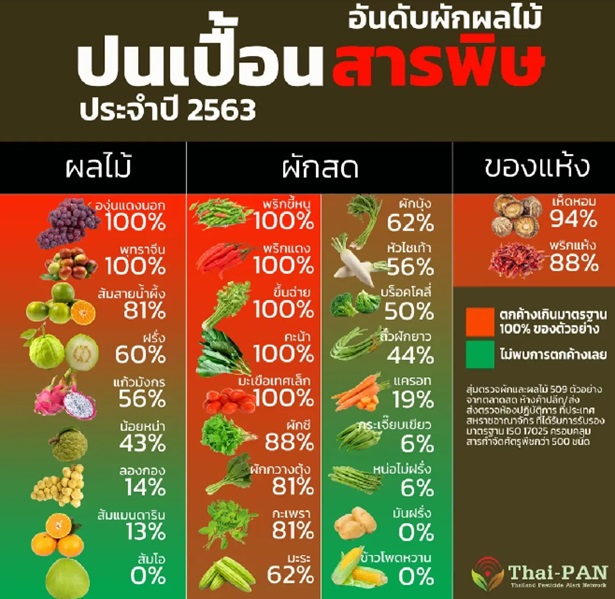Shine Muscat Grapes: Food Safety Issues
After the Pesticide Alert Network (Thai-PAN), Smart Buy Magazine, and the Foundation for Consumers revealed the results of random testing of 24 samples of “Shine Muscat grapes” throughout Bangkok and its vicinity, which found a high level of agricultural chemical residues in the grapes exceeding the standard. When this story was released, it quickly shocked consumers. Consumers suddenly “stopped buying and eating” until the phenomenon of Shine Muscat grapes left in the market everywhere. Even though many vendors heavily reduced the price, they still couldn’t sell them.
But recently… the Food and Drug Administration (FDA) has come out to clarify the facts further that The previously released information may have created a misunderstanding. In fact, the results of the Shine Muscat grape test that found 36 residues were only slightly above the standard. In other words, contaminants were found but not exceeding the safety standard.
As for the doubt that the contaminants were absorbed into the Shine Muscat grapes and could not be washed off, the fact is that some of the substances are substances used during planting, causing the tree to absorb the substances for food, but it does not mean that the substances are absorbed into the fruit. Therefore, washing the fruit before eating in the correct way will allow it to be eaten normally.
It is not only Shine Muscat grapes that have residues found. But if we go back to 2020 or 4 years ago, Thai-PAN previously reported the results of random testing for chemical residues in various vegetables and fruits in Thai markets. It was reported that many types of fresh vegetables and fruits had a high level of residues as well. The analysis was done on 509 random samples of vegetables and fruits from all over the country (comprising 9 types of fruits, 18 types of vegetables, and 2 types of dried goods) to provide guidelines for choosing to consume vegetables that are less risky.
The top 7 fruit categories with the highest levels of residues exceeding the standard are:
1. Imported red grapes, 100% residue
2. Chinese dates, 100% residue
3. Honey oranges, 81% residue
4. Guava, 60% residue
5. Dragon fruit, 56% residue
6. Custard apple, 43% residue
7. Longkong, 14% residue
1. Imported red grapes, 100% residue
2. Chinese dates, 100% residue
3. Honey oranges, 81% residue
4. Guava, 60% residue
5. Dragon fruit, 56% residue
6. Custard apple, 43% residue
7. Longkong, 14% residue
Before buying vegetables and fruits, you must know the source of the product, the safe growing area, and always wash them thoroughly before eating. The agency has also advised consumers that if they want to reduce their exposure to residues from vegetables and fruits as much as possible, they should consume products that clearly state the origin of production, such as vegetables and fruits from plots that follow organic farming guidelines. In addition, washing them multiple times can reduce toxins to some extent, but not completely, depending on the type of chemicals used in the spray. Meanwhile, turning to consume local vegetables and fruits that are known to have a lower-risk method, and if possible, growing your own vegetables is the safest method.
However, in both the recent case of “Shine Muscat grapes” and the cases in which residues were found in other fruits according to the aforementioned past reports, All of these reflect consumers' greater awareness that since we do not grow our own vegetables and fruits to eat, but buy them from the market, they are certainly not 100% clean and safe. Therefore, before consuming them every time, they must be washed as thoroughly as possible.
The FDA has recommended the correct and appropriate way to wash vegetables and fruits to reduce the amount of pesticide residues, with 3 methods as follows:
Method 1: Washing with plain water
• Soak in water for 15 minutes (shaking/stroking gently)
• Then rinse under running water again for no less than 30 seconds.
• This method is the best way to wash vegetables and fruits.
• Soak in water for 15 minutes (shaking/stroking gently)
• Then rinse under running water again for no less than 30 seconds.
• This method is the best way to wash vegetables and fruits.
Method 2: Soak in water mixed with sodium bicarbonate Or baking soda
• Use 1 teaspoon or 5 grams of sodium bicarbonate per 4 liters of water
• Soak vegetables and fruits for 15 minutes, then rinse with clean water
• Use 1 teaspoon or 5 grams of sodium bicarbonate per 4 liters of water
• Soak vegetables and fruits for 15 minutes, then rinse with clean water
Method 3: Soak in salted water
• Soak in sodium chloride solution (1 tablespoon or 18 grams of salt per 2 liters of water)
• Soak vegetables and fruits for 15 minutes, then rinse with clean water
• Soak in sodium chloride solution (1 tablespoon or 18 grams of salt per 2 liters of water)
• Soak vegetables and fruits for 15 minutes, then rinse with clean water
In addition, consumers should choose to buy vegetables and fruits that are certified organic or GAP, and should consume vegetables and fruits in season to reduce the risk of contaminants that farmers often use with out-of-season crops. They should also consume a variety of vegetables and fruits, and not the same type repeatedly. These practices also help to avoid residues in vegetables and fruits.
Reference: BangkokBiz

